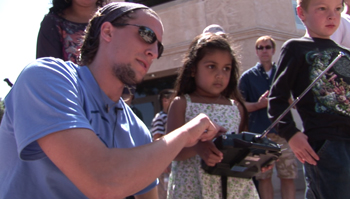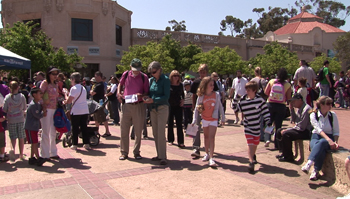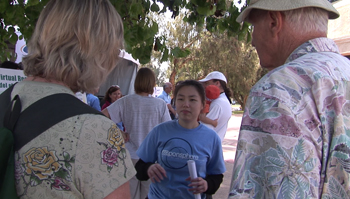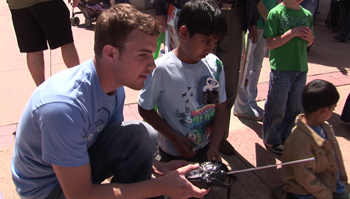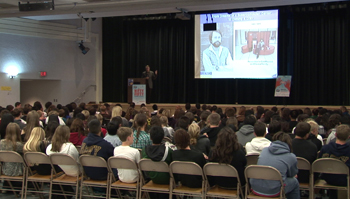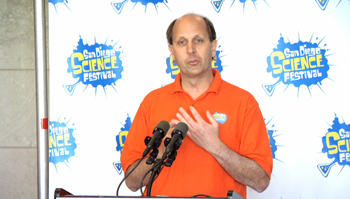San Diego Science Festival Ends on a High Note for UC San Diego
|
Attendance at Expo Day, the culmination of the month-long and first-ever San Diego Science Festival, was more than triple what organizers were expecting. At one point, the backup of cars on Interstate 5 waiting to exit for Balboa Park stretched five miles. The Expo Day crowd brought to 200,000 the total number of people attending more than 500 free events during the Festival.
“We could not have imagined how well the people of San Diego and the biotechnology and technology communities would embrace our efforts to highlight continued education in the sciences,” said Larry Bock, the executive director of the Festival and the inspiration behind San Diego’s inaugural science event. “With 50,000 visitors to the very first Expo Day, it appears we hit on something the public very much wants. We had such a great response and our sponsors couldn’t be more pleased. Now we have to roll up our sleeves and get to work on the festival for 2010.”
|
The San Diego Supercomputer Center (SDSC), Calit2, UC San Diego Extension, BioBridge, Jacobs School of Engineering, and other UCSD programs are among more than 125 leading science and community organizations that collaborated with organizers to make the San Diego Science Festival a success. (Many attended a March 26 “thank-you” event at Calit2 on the UC San Diego campus.)
Expo Day
Expo Day was a rare opportunity for UC San Diego to expose thousands of young San Diegans – and their parents – on a single day to the world-class university in their own backyard. “There were students of all levels and families from across the county, with the rich diversity of backgrounds and languages that make San Diego such a wonderful place to live,” said Diane Baxter, director of educational outreach at SDSC. “Most had never heard of SDSC and expressed strong interest in our role enabling scientific discovery. I believe that this event probably gave SDSC more public exposure than any other since I’ve been at the supercomputer center.” At its booth, SDSC ran out after giving away 2,000 calendars, but the booth’s main attraction was a set-up of six computers that allowed kids (of any age) to play an interactive game or to travel through Google Earth. In a separate booth, SDSC and its partners in the SMART Team program allowed students to build physical models of proteins from science kits.
|
The big hit of the Calit2 exhibit was Gizmo, Calit2’s family of wireless rovers designed to carry cameras and wireless access points remotely to disaster sites in order to get communications going again in an emergency. While Gizmo was a hit with kids as young as 5 years old (who waited patiently in line to test-drive them), the mobile platforms also have a serious purpose: to help victims and first responders in the wake of a disaster. Calit2 researchers also demonstrated wireless medical devices, including a machine that continuously monitors a victim’s pulse rate and blood-oxygen level, and streamed solar radiation, temperature and other environmental data to the booth from a weather-monitoring station on top of a nearby building.
The technologies grew out of several major disaster-response projects, including the NIH-funded WIISARD project, and NSF-funded RESCUE and ResponSphere projects. “It was wonderful to have this opportunity to test our technologies after spending four or five years developing them,” explained Calit2’s Rao.
|
UC San Diego students had the opportunity to present their research to younger students. “If I were 10 years old, something like this would be really helpful because you get to see all the fascinating things that motivate you to go into science,” said Mabel Zheng, a computer science sophomore in the Jacobs School of Engineering who began working on a Calit2 research project while still a freshman. “It is especially helpful at an event like this, when you have so many disciplines represented; it’s not just about computers, it’s not just about astronomy.”
Other Expo Day exhibitors from UC San Diego included the Division of Physical Sciences. Physics Professor Ivan Schuller hosted a booth about nanotechnology that introduced participants to the interesting properties that arise in materials “When Things Get Small” (the title of Schuller’s TV documentary about nanoscience, produced by UCSD-TV with funding from NSF and Calit2). Elsewhere in Balboa Park , students affiliated with UCSD’s Biomedical Engineering Society staged activities designed to get even the youngest visitors involved in science, e.g., using water, oil, food coloring and Alka-Seltzer to make mini lava lamps.
|
Nifty Fifty
More than 20 faculty affiliated with UC San Diego participated in the Festival’s Nifty Fifty program, which sent top science and technology leaders to speak to junior and senior high school classes throughout March. The Nifty Fifty include researchers who uncovered wreckage from the Titanic, have founded and run some of the most innovative high technology and life sciences companies, are designing the next generation of “thinking” computers and machines, are keeping us safe through the design of earthquake-resistant buildings and bridges, and are pioneering lifesaving medical therapies through genetic research and drug development. Nifty Fifty presenters included Calit2 director Larry Smarr; Frieder Seible, dean of the Jacobs School of Engineering and a world-renowned structural engineer; Jeanne Ferrante, assistant dean of the Jacobs School and a computer science and engineering professor; mechanical and aerospace engineering professor Alison Marsden; bioengineering professor Shu Chien; and SDSC director Francine Berman.
|
Science on the Mesa
On April 1, in connection with the Festival, “Science on the Mesa ” drew high-school students to La Jolla research facilities. Crystals made from novel materials, levitating magnets, powerful lasers, and the making of fuel from vegetable oil wowed students from Sweetwater High School who visited the Division of Physical Sciences. They learned how UCSD Physics Professor Brian Maple’s research team makes crystals and studies their magnetic properties. Dean Mark Thiemens showed students the “Doom Laser” in his atmospheric chemistry lab, as well as a piece of the Nakhla meteorite — famous for being the only meteorite known to have hit and killed a dog. Students learned about the similarities in the sleuthing methods used by forensic scientists and the methods used by atmospheric chemists to understand atmospheric processes. UC San Diego undergraduates in the Biofuels Action and Awareness Network, and their mentor Skip Pomeroy, took the high school students through all the steps involved in the synthesis and analysis of biodiesel from waste cafeteria oil.
|
UC San Diego’s Division of Biological Sciences also brought students together for a session about how biologists use model organisms, such as bacteria, worms and fruit flies to study fundamental genetic and biological processes. They also taught students about the techniques biologists use to isolate and visualize DNA, separate and characterize proteins in cells, and study the physiology and behavior of organisms. In addition, the Division drew hundreds of people to a lecture by Michael Shermer, columnist for Scientific American and founder of The Skeptics Society, on Why Darwin Matters: Evolution, Intelligent Design, and the Battle for Science and Religion. Once an envangelical Christian and creationist, Shermer now defends evolutionary theory and offered the public an insider’s guide to the evolution-creation debate and why science should be embraced by people of all beliefs.
Small Wonders
High-school students also visited UC San Diego’s stem-cell research facilities and got the chance to talk with UCSD School of Medicine Professor Larry Goldstein, one of the world’s top stem-cell researchers. About 175 students visited the campus for a program called “Small Wonders” – a day of hands-on nanotechnology experiments, lectures and visits to one-of-a-kind facilities such as Calit2’s StarCAVE virtual-reality environment.
Career Night
Targeting adults, UC San Diego Extension welcomed more than 600 people to its free “Career Night: Your Future in Science, Technology and Business,” on March 25 at the UC San Diego Extension Sorrento Mesa Center. Informative workshops on new and emerging trends in science and business were offered along with job tips from local professional associations. Workshops led by UC San Diego Extension faculty at Career Night included:
- Future Technologies in Life Science
- BizTalk: An Entrepreneur’s View of the Technology and Life Sciences Industries
- Engineering Career Opportunities – Present and Future
- Looking Into The Legal Field: Career Paths in Paralegal and Intellectual Property
- Opportunities in Financial Careers: A Brighter Side of the Job Market
- Healthcare Careers for the Non-Medical Professional
- Recruiters Roundtable
- Transitioning into Retirement
- How to Get a Job at UC San Diego (the third largest employer in San Diego County )
“Job market fluctuations bring both change and opportunity,” said Vicki Krantz, director of business, science and technology programs at UC San Diego Extension. “For recent and mid-career college graduates, continuing education is an increasingly attractive way to transition to areas of employment that are in higher demand.” Sponsors of Career Night included ESET, General Atomic, Gen-Probe, Illumina, Jobing.com, Lockheed Martin, ResMed and Vertex.
Related Links
San Diego Science Festival
Small Wonders (article)
Nifty Fifty: Larry Smarr (article)
Media Contacts
Doug Ramsey, 858-822-5825, dramsey@ucsd.edu

